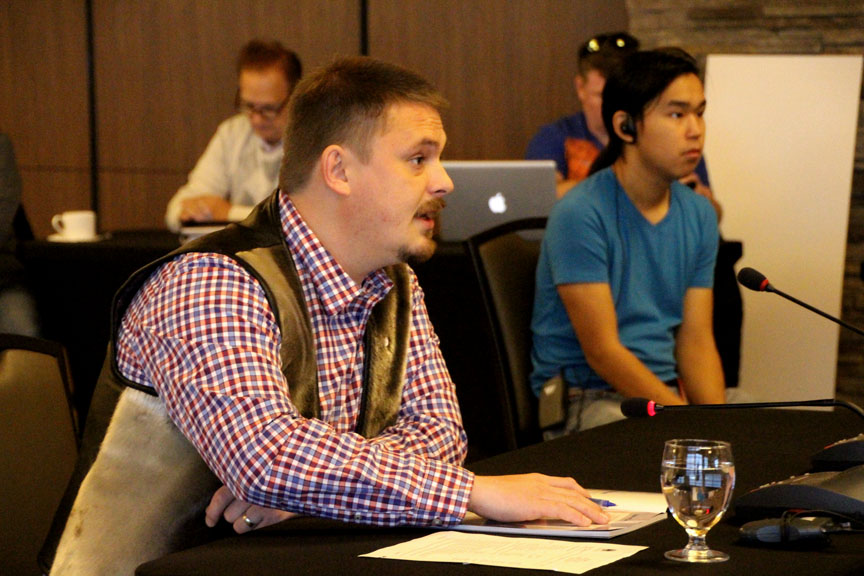Funding solution in sight, says QIA
After once again running into the red, the regional Inuit org says new cash coming

P.J. Akeeagok, president of the Qikiqtani Inuit Association, introduces the Inuit organization’s 2016-2017 annual report at QIA’s annual general meeting held Oct. 3 inside Iqaluit’s Frobisher Inn. (PHOTO BY BETH BROWN)
(Updated, Oct. 4, 3:50 p.m)
The Qikiqtani Inuit Association says the deficit it posted in its general fund over the past fiscal year is the result of it being shortchanged by Nunavut Tunngavik Inc. However, the regional Inuit organization says additional cash contributions from NTI that started this fiscal year should help prevent future shortfalls.
The QIA posted a deficit in its general fund, which it uses to pay for core operations, of $544,000 for 2016-17. The general fund posted a smaller deficit, of $366,927, the previous year.
(However, for both years the organization remained in the black if you count revenues earned from mining royalties and its economic development arm. For 2016-17, they posted an overall surplus of about $3 million.)
“We feel we are underfunded,” the QIA’s finance director, Scott Wells, said of the operations fund while presenting the organization’s 2016-17 financial statements at the QIA annual general meeting in Iqaluit Oct. 3.
Last year, QIA Secretary-Treasurer Joe Attagutaluk made the same observation in a report on the organization’s 2015-16 fiscal year.
In that 2016 report, Attagutaluk complained that while 52 per cent of Nunavut beneficiaries live in the Qikiqtani region, the QIA only gets 40 per cent of the funding that NTI gives to regional Inuit associations each year.
This year, Wells said NTI will increase the funding it gives the region to better reflect the size of the Baffin population.
“We need about three-quarters of a million dollars in additional funding,” he said. NTI’s contribution to the QIA in 2016-17 was about $9.6 million, not enough to head off the $544,000 deficit.
But this year, the QIA will get more, Wells said.
“We should be getting around $900,000 extra this year. We should be able to turn around that deficit,” he said.
The QIA’s annual report was released at the opening of the AGM.
That report, as well as Well’s update, talks about a change in revenue policy and a new legacy fund created at last year’s board meeting.
The legacy fund was created, in part, with royalties earned through the Mary River Inuit Impact Benefit Agreement struck with Baffinland Iron Mines Corp. In 2013. The legacy fund ran a balance of $29.6 million as of March 31.
“We’re seeing growth in the legacy fund just one year later,” Wells said, adding that the new fund has grown by $3.4 million.
Wells noted that the fund’s growth does not account for the $7.2 million in unpaid royalties that the QIA won through an arbitration settlement with Baffinland.
The $7.2 million will go into the legacy fund as of April 1, 2018, the annual report said.
“The legacy fund is designed to ensure that revenues placed into the legacy fund are never used for QIA operational purposes, thereby protecting long-term benefits for Inuit,” the report said.
Revenue for the legacy fund comes from:
• Inuit Impact and Benefit Agreement payments from major projects;
• money received from NTI from the mining of Inuit owned minerals;
• money received from sand and gravel projects on Inuit Owned Land;
• dividends from the Qikiqtaaluk Corp. and the Nunasi Corp.;
• money received from any investments earned by the legacy fund; and;
• surplus revenues from the QIA’s economic development fund.
Revenue from the legacy fund will be moved into an offshoot benefits fund, meant specifically for community programming.
“In this way, QIA can ensure a stable base of funding to run programs even if revenues change over time,” the report said.
A float of $2 million has been placed in that new fund.
“We have a budget immediately to start funding programs,” Wells said.
The QIA annual report also mentions:
• Over $100,000 in QIA contributions to Clyde River’s successful legal battle against the National Energy Board on seismic testing in Baffin Bay and Davis Strait, where $40,000 went to court costs, $57,509 went towards workshops and consultations for the community and $12,165 was given to cover travel.
• A decision to allocate $200,000 for 80 new scholarships for Qikiqtani Inuit to pursue postsecondary education, and;
• $2.5 million for programs under the QIA’s Community Initiatives Program, the Ilagiiktunut Fund, and its Grants and Contributions Fund to promote traditional arts, Nunavut music and on-the-land training.
“The programs have engaged Inuit children, youth, elders and families in ways that help preserve our culture and foster community,” the report said.
In his president’s letter, QIA President P.J. Akeeagok celebrates the opening of Qausuittuq National Park in Resolute Bay and the announcement of boundaries for Tallurutiup Imanga National Marine Conservation Area near Pond Inlet.
This version of the story clarifies possibly confusing information about the status of QIA’s general fund, as well as QIA’s funding agreement with NTI, contained in earlier versions of the story.
2016-17 QIA Annual Report by NunatsiaqNews on Scribd





(0) Comments